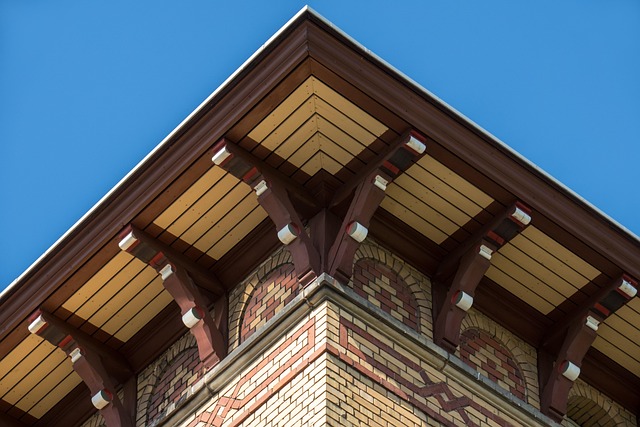Green roofs represent environmental roofing solutions that revolutionize urban water management by integrating vegetation into rooftops. These living spaces offer multiple benefits, including natural rainwater purification, flood prevention, groundwater recharge, enhanced air quality, and insulation. By mitigating the urban heat island effect and fostering biodiversity, green roofs contribute to more sustainable and resilient cities while harmoniously merging nature with urban landscapes. Implementing these solutions involves selecting suitable vegetation, proper waterproofing, and regular maintenance, ultimately transforming urban spaces for a brighter future.
Water management is a pressing urban challenge, but green roofs offer an innovative, sustainable solution. This article explores the transformative power of integrating environmental roofing solutions into urban landscapes. We delve into the science behind green roofs, their pivotal role in water management, and the multifaceted benefits they bring to cities. From understanding the basics to implementing best practices, we uncover how these vibrant ecosystems contribute to a greener, more resilient future for urban spaces.
- Understanding Green Roofs: An Environmental Approach to Roofing
- The Role of Green Roofs in Sustainable Water Management
- Implementing Green Roof Solutions: Benefits and Best Practices
- Future-Proofing Urban Spaces: The Impact of Green Roofs on Environmental Roofing Solutions
Understanding Green Roofs: An Environmental Approach to Roofing
Green roofs, also known as eco-roofs or living roofs, are an innovative and environmentally friendly approach to roofing that has gained significant attention in recent years. This sustainable solution involves planting and growing vegetation on a rooftop, creating a vibrant green space that offers numerous environmental benefits. By integrating nature into urban landscapes, green roofs provide an effective strategy for water management, particularly in the context of environmental roofing solutions.
These roofs function as a natural sponge, absorbing rainwater and reducing the risk of flooding during heavy downpours. The plant material acts as a filter, removing pollutants and improving water quality before it enters drainage systems. Furthermore, green roofs contribute to energy efficiency by providing insulation, reducing the urban heat island effect, and potentially extending the lifespan of the underlying roofing materials. With their multi-faceted advantages, green roofs represent a cutting-edge method in sustainable water management, offering cities an opportunity to embrace nature and create healthier, more resilient urban environments.
The Role of Green Roofs in Sustainable Water Management
Green roofs, as an innovative environmental roofing solution, play a pivotal role in sustainable water management. These vegetative layers on rooftops serve as natural buffers against heavy rainfall, significantly reducing the strain on urban drainage systems. By absorbing and slowing down rainwater, green roofs prevent flash floods and help recharge groundwater supplies. The plant life also acts as a natural filter, removing pollutants and improving water quality before it flows into nearby streams and rivers.
This eco-friendly approach not only mitigates the impact of urban runoff but also provides additional benefits such as reduced energy consumption (due to heat island effect mitigation) and improved air quality. As cities worldwide grapple with the challenges of urbanization, green roofs emerge as a holistic water management strategy that seamlessly integrates nature into the built environment, fostering a more sustainable future.
Implementing Green Roof Solutions: Benefits and Best Practices
Implementing green roof solutions offers a sustainable approach to water management, providing numerous benefits for both urban environments and buildings. These environmental roofing solutions act as natural barriers against extreme weather events, absorbing rainwater and reducing the strain on traditional drainage systems. The process involves designing and installing vegetation-covered roofs that mimic natural landscapes, thereby enhancing biodiversity and creating microclimates in urban spaces.
Best practices in green roof implementation include careful selection of suitable vegetation based on local climates and specific building requirements. Proper waterproofing and drainage layers are essential to prevent damage while ensuring efficient water infiltration and percolation. Regular maintenance is crucial for keeping the roofs healthy, with regular weeding, irrigation management, and monitoring for pest issues. Green roofs not only contribute to water conservation but also provide insulation benefits, improving energy efficiency in buildings.
Future-Proofing Urban Spaces: The Impact of Green Roofs on Environmental Roofing Solutions
Green roofs are emerging as a powerful tool in future-proofing urban spaces, offering an innovative approach to environmental roofing solutions. By integrating vegetation into rooftops, these eco-friendly systems provide multiple benefits, addressing pressing urban challenges. One of the primary impacts is improved water management; green roofs act as natural sponges, absorbing and slowing down stormwater runoff, reducing the strain on traditional drainage systems. This simple yet effective method helps alleviate flooding risks and promotes a more sustainable water cycle in cities.
Furthermore, these vegetated roofs contribute to enhanced environmental sustainability. They offer insulation, reducing the urban heat island effect, and can help mitigate air pollution by absorbing noxious gases. The biodiversity they foster also supports local ecosystems, providing habitats for various plant and animal species. With climate change posing significant threats to urban environments, green roofs emerge as a practical solution, combining aesthetics with ecological value, and ensuring a brighter, more resilient future for our cities.
Green roofs represent a promising solution for sustainable water management, offering significant environmental benefits. By integrating vegetation into urban landscapes, these roofing systems mitigate stormwater runoff, improve air quality, and contribute to biodiversity. As cities seek to future-proof themselves against climate change, adopting green roof technologies is not just an innovative choice but a strategic one. Implementing these solutions can lead to more resilient urban spaces while promoting a harmonious balance between concrete jungles and the natural world. Environmental roofing solutions like green roofs are key to creating sustainable communities that thrive in harmony with their surroundings.
